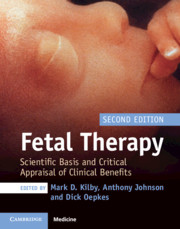Book contents
- Fetal Therapy
- Fetal Therapy
- Copyright page
- Dedication
- Contents
- Contributors
- Foreword
- Section 1: General Principles
- Section 2: Fetal Disease: Pathogenesis and Treatment
- Red Cell Alloimmunization
- Structural Heart Disease in the Fetus
- Fetal Dysrhythmias
- Manipulation of Fetal Amniotic Fluid Volume
- Fetal Infections
- Fetal Growth and Well-being
- Preterm Birth of the Singleton and Multiple Pregnancy
- Complications of Monochorionic Multiple Pregnancy: Twin-to-Twin Transfusion Syndrome
- Complications of Monochorionic Multiple Pregnancy: Fetal Growth Restriction in Monochorionic Twins
- Complications of Monochorionic Multiple Pregnancy: Twin Reversed Arterial Perfusion Sequence
- Complications of Monochorionic Multiple Pregnancy: Multifetal Reduction in Multiple Pregnancy
- Fetal Urinary Tract Obstruction
- Pleural Effusion and Pulmonary Pathology
- Surgical Correction of Neural Tube Anomalies
- Fetal Tumors
- Congenital Diaphragmatic Hernia
- Chapter 47 Congenital Diaphragmatic Hernia: Pathophysiology and Antenatal Assessment
- Chapter 48 Congenital Diaphragmatic Hernia: In Utero Treatment Today and Tomorrow
- Fetal Stem Cell Transplantation
- Gene Therapy
- Section III: The Future
- Index
- References
Chapter 48 - Congenital Diaphragmatic Hernia: In Utero Treatment Today and Tomorrow
from Congenital Diaphragmatic Hernia
Published online by Cambridge University Press: 21 October 2019
- Fetal Therapy
- Fetal Therapy
- Copyright page
- Dedication
- Contents
- Contributors
- Foreword
- Section 1: General Principles
- Section 2: Fetal Disease: Pathogenesis and Treatment
- Red Cell Alloimmunization
- Structural Heart Disease in the Fetus
- Fetal Dysrhythmias
- Manipulation of Fetal Amniotic Fluid Volume
- Fetal Infections
- Fetal Growth and Well-being
- Preterm Birth of the Singleton and Multiple Pregnancy
- Complications of Monochorionic Multiple Pregnancy: Twin-to-Twin Transfusion Syndrome
- Complications of Monochorionic Multiple Pregnancy: Fetal Growth Restriction in Monochorionic Twins
- Complications of Monochorionic Multiple Pregnancy: Twin Reversed Arterial Perfusion Sequence
- Complications of Monochorionic Multiple Pregnancy: Multifetal Reduction in Multiple Pregnancy
- Fetal Urinary Tract Obstruction
- Pleural Effusion and Pulmonary Pathology
- Surgical Correction of Neural Tube Anomalies
- Fetal Tumors
- Congenital Diaphragmatic Hernia
- Chapter 47 Congenital Diaphragmatic Hernia: Pathophysiology and Antenatal Assessment
- Chapter 48 Congenital Diaphragmatic Hernia: In Utero Treatment Today and Tomorrow
- Fetal Stem Cell Transplantation
- Gene Therapy
- Section III: The Future
- Index
- References
Summary
Congenital diaphragmatic hernia (CDH) is a life-threatening surgically correctable congenital birth defect (3/10 000 live-born babies) [1]. Survival chances are dependent on the presence of associated malformations and severity of lung hypoplasia. Mortality remains up to 30% [2]. In the previous chapter we have outlined how fetuses with the suspicion of CDH should be assessed, using genetic testing and modern imaging techniques. Individualized prognosis of isolated CDH can be made prenatally by measurement of lung size, the presence of the liver in the thorax, and the side of the defect [3]. Patients with predicted poor prognosis are ideal candidates for an intervention that may improve the outcome. Such intervention is not aiming at repairing the diaphragmatic defect, as it can be easily closed after birth: it rather should reverse pulmonary hypoplasia (i.e. stimulate lung growth) before birth. Historically this was attempted by anatomical repair of the defect in utero, yet results were suboptimal [4].
- Type
- Chapter
- Information
- Fetal TherapyScientific Basis and Critical Appraisal of Clinical Benefits, pp. 503 - 511Publisher: Cambridge University PressPrint publication year: 2020

